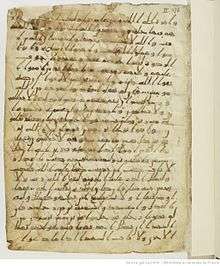Codex Parisino-petropolitanus

The codex Parisino-petropolitanus is one of the oldest extant manuscripts of the Quran, dated to the 7th or 8th century.[1]
The largest part of the fragmentary manuscript are held at the Bibliothèque nationale de France, Paris, as BnF Arabe 328(ab), with 70 folia. Another 46 folia are kept in the National Library of Russia in Saint-Petersburg. Two additional folia have been preserved, one kept in the Vatican Library (Vat. Ar. 1605/1) and the other in the Khalili Collection in London (KFQ 60). Taken together, the extant manuscripts cover about 45% of the text of the Quran.
The manuscript
BnF Arabe 328 consists of six parts, labelled a–f. Of these, parts (a) and (b) were later recognized as having formed part of a single original manuscript.
- BnF Arabe 328(a), 56 leaves (foll. 1–56), with additional leaves held by the Vatican Library, the Khalili Collection and the National Library of Russia.[2] This portion accounts for about 26% of the text of the Quran.
- BnF Arabe 328(b), 14 leaves (foll. 57–70).
The remaining four parts of BnF Arabe 328 are from different Quranic manuscripts.
- BnF Arabe 328(c), 16 leaves (foll. 71–86), with two additional leaves discovered in Birmingham and carbon-dated to before 645. (formerly bound with an unrelated late 7th century Quranic manuscript) in 2015.
- BnF Arabe 328(d), 3 leaves (foll. 87–89).
- BnF Arabe 328(e), 6 leaves (foll. 90–95).
- BnF Arabe 328(f), 2 leaves (foll. 96–97).
The manuscript Arabe 328(ab) is fragmentary. Originally it contained an estimated 210 to 220 leaves, of which 118 are extant (70 in Paris, 46 in Saint-Petersburg, and one each in Rome and London).[3] The preserved text spans sura 2:275 to 72:2, with lacunae in between. Overall, it contains about 45% of the Quranic text.[3] It was produced by five scribes, probably working concurrently in order to meet demand for a fast production.[4] All of the hands use the Hijazi script.
Déroche says that the production of codex Parisino-petropolitanus could be dated as far back as the late 7th century CE (third quarter of the 1st century AH).[4] David S. Powers agrees with this early date.[5] Others agree with a date in the early 8th century CE, which Déroche also advocated in some of his earlier work.[6] Still some suggest significantly later dates.[7]
Déroche writes of many mere orthographic differences between the text of the codex Parisino-petropolitanus and the standard text of today.[8] Overall, the contents of the text are not hugely different from those of today's Quran.[9] Orthography does not explain all of the differences, however.[10] Some remaining differences can be explained as copyist mistakes.[11] A few others are substantive variants according to Déroche, including some non-canonical variants.[12] Powers says that some of these substantive variants show that the text of the Quran remained "fluid" and open to change until the end of the 7th century.[5]
History
The manuscript had been stored with other Quranic manuscripts in the Mosque of Amr ibn al-As in Fustat, Egypt. During the Napoleonic expedition to Egypt in 1798/99, French Arabist Jean-Joseph Marcel (1776–1856) acquired a first lot of folios. A few more pages were bought by Jean-Louis Asselin de Cherville (1772–1822) when served as vice-consul in Cairo some years later. Cherville's collection of Arabic manuscripts were sold to the Bibliothèque nationale after his death in 1822. The portion bought by Jean-Joseph Marcel was sold by his heiress to the Russian government and in 1864 became part of the collection of the Public Imperial Library (now National Library of Russia) in Saint-Petersburg. Besides the portions bought by Marcel and de Cherville, two additional folia reached Europe separately, one is now in the Vatican Library (Vat. Ar. 1605/1) and the other in the Khalili Collection in London (KFQ 60). [13] In the 1983 catalogue of the BnF, foll. 1–56 were described as a separate entity, Arabe 328(a), from foll. 57–70, Arabe 328(b). It was only later realised that the two parts once formed part of the same manuscript.
See also
References
- ↑ Rippin 2009, p. 706.
- ↑ Small 2011, p. 21.
- 1 2 Déroche 2009, p. 172.
- 1 2 Déroche 2009, p. 177.
- 1 2 Powers 2011, p. 193.
- ↑ Dutton 2001, p. 71.
- ↑ Dutton 2001, pp. 71 & 85.
- ↑ Déroche 2009, p. 173.
- ↑ Rippin 2009, p. 708.
- ↑ Déroche 2009, p. 174.
- ↑ Déroche 2009, p. 175.
- ↑ Déroche 2009, p. 176–177.
- ↑ Deroche (2009:171)
- Déroche, François (2009). "English Summary" (PDF). La transmission écrite du Coran dans les débuts de l'islam: le codex Parisino-petropolitanus. Brill Publishers. ISBN 9004172726.
- Déroche, François (2013). Qur’ans of the Umayyads: A First Overview. Brill Publishers. ISBN 9789004261853.
- Dutton, Yasin (2001). "An early muṣḥaf according to the reading of Ibn ʻĀmir". Journal of Qur'anic Studies. 3 (1): 71–89. doi:10.3366/jqs.2001.3.1.71. (subscription required (help)).
- Powers, David S. (2011). Muhammad Is Not the Father of Any of Your Men: The Making of the Last Prophet. University of Pennsylvania Press. ISBN 9780812205572.
- Rippin, Andrew (2009). "Review: La transmission écrite du Coran dans les débuts de l'islam: le codex Parisino-petropolitanus, by François Déroche". Journal of the American Oriental Society. 129 (4): 706–708. JSTOR 25766923. (subscription required (help)).
- Small, Keith E. (2011). Textual Criticism and Qur'an Manuscripts. Lexington Books. ISBN 9780739142912.
External links
- Photographic facsimile at the Bibliothèque nationale de France
- Corpus Coranicum online edition:
- BnF ar. 328(a), 56 foll.
- BnF ar. 328(b), 14 foll.